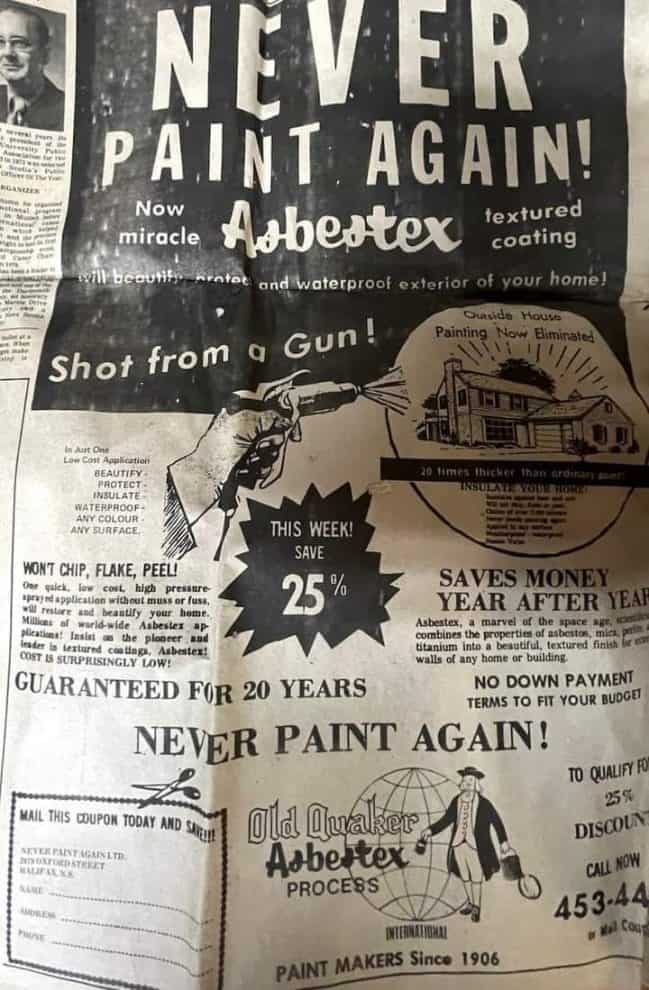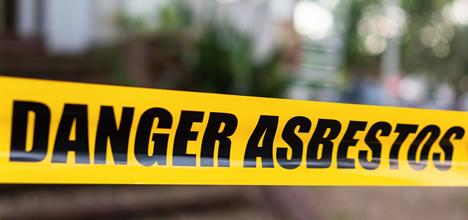When I first started working with exterior wall coatings it was way back in 1986. That seems such a long time ago, and was!
Little did I know that as a naïve teenager, working with my late father, I was handling asbestos.
Yes, up until 1986, asbestos was commonly found in exterior wall coatings, albeit in small amounts.
Well I am still here (!) many years later so it can’t have been that bad, but thankfully exterior textured wall coatings, and a range of other building materials, no longer contain asbestos as it is now widely Known how harmful it can be.
What actually is asbestos?
Asbestos is a group of naturally occurring minerals that were once widely used in building materials due to its durability, strength and fire retardant qualities.
It was mined out of the ground.
Unfortunately, inhaling its microscopic fibres can lead to serious health complications like lung cancer, mesothelioma or asbestosis.
Buildings worldwide contain asbestos-containing materials such as floor tiles, roofing materials and cladding.
How Asbestos Got Into Buildings
Asbestos was a widely used material in building products such as insulation, roofing and ceiling tiles.
Although it is no longer widely used, remnants may still exist in older buildings.
Asbestos can be hazardous for those who reside and/or work in these buildings.
When breathed-in and become airborne, it may cause asbestosis, lung cancer and mesothelioma.
What is mesothelioma?
Mesothelioma is a type of cancer that develops in the lining that covers the outer surface of some of the body’s organs. It’s usually linked to asbestos exposure.
Mesothelioma mainly affects the lining of the lungs (pleural mesothelioma), although it can also affect the lining of the tummy (peritoneal mesothelioma), heart or testicles.
More than 2,700 people are diagnosed with mesothelioma each year in the UK.
Most cases are diagnosed in people aged 75 and over, and men are affected more commonly than women.
Unfortunately, it’s not possible to cure mesothelioma, although treatment can help control the symptoms.
Source: nhs.uk/conditions/mesothelioma
In my own locality, former workers at Devonport dockyard often caught this deadly disease as asbestos was used in ship building.
Construction workers who disturb or remove asbestos-containing materials (ACM) are particularly at risk. Without appropriate protection such as protective clothing and gloves, they could get sick from inhaling fibres that become airborne during a demolition project.
Asbestos can be difficult to detect, so it is wise to hire a professional for any asbestos material you might be working on.
If the material has been significantly damaged (i.e., crushed or worn down), you must have it repaired or removed before beginning renovation projects.
What Was Asbestos Used For
Asbestos has long been used in products and materials due to its strength and resilience; it’s resistant to fire, heat, sound and chemicals while being cost-effective.
As a result, asbestos had become widely popular across construction projects around the world.

When asbestos was utilised in buildings, it was often added to roofing shingles, insulation, ceiling tiles, floor tiles, joint compounds and adhesives.
It could also be utilised for making acoustical plaster as well as spray-coating pipes and other components of buildings for protection.
Additionally, graphite was employed in friction products like automobile clutch and brake linings and gaskets.
Tradesmen who worked with asbestos-containing materials in buildings, such as construction workers, plumbers, electricians and auto mechanics were particularly vulnerable to exposure to this hazardous substance. They inhaled microscopic fibres released by those materials on a daily basis.
As you can see from the 1970’s Canadian advert above, asbestos was used in wall coatings, and was praised as a miracle product. Until they found out how bad it was for peoples heath that is.
Where Can Asbestos Be Found
Asbestos is a naturally occurring mineral that can release microscopic fibres into the air when inhaled. If inhaled, these microscopic particles can become lodged in your lungs or other parts of the body and lead to long-term illnesses like lung cancer and asbestosis.
If you think a material in your building may contain asbestos, sample it and send it to an accredited laboratory for analysis. This is the only way to be certain of what’s present.
Most likely, asbestos will be found in ceilings, walls and floorboards of a building. You might also come across asbestos insulation, surfacing materials (like wall coatings and paint), as well as gaskets on doors and windows.
If you have an older house in the UK and have an “Anderson” air raid shelter from World war 2 in the back garden, it probably also contains asbestos, this is especially important as many were repurposed to sheds and are still in use today.
What Are the Dangers of Asbestos?
Asbestos poses a great risk to your health.
It has the potential to cause various lung diseases, such as asbestosis, mesothelioma and lung cancer.
If you believe you may have been exposed to asbestos, contact your doctor right away. They can perform chest X-rays and lung function tests to check for damage to your lungs.
Your doctor may refer you to a specialist in asbestos-related disease for further testing.

They can check for fluid build-up around your lungs (pleural effusions) and whether there are small patches of scarring on the lining of your lungs, known as plaques.
These can become thicker over time and make it harder to breathe, leading to breathlessness and difficulty coughing.
If the symptoms don’t improve, your doctor may suggest taking oxygen supplements or placing you on a lung transplant list for additional assistance.
Yep it really is that serious.
What to do if you suspect asbestos is present in your home?
According to the Health and Safety executive, asbestos can be commonly found in homes built or refurbished before the year 2000.
They put together a handy guide as to where in the home you may possibly find this hazardous material.
Asbestos commonly found Inside the home.
- Asbestos cement Water tank
- Pipe lagging
- Loose fill insulation
- Textured decorative coating eg artex
- AIB ceiling tiles
- AIB bath panel
- Toilet seat and cistern
- AIB behind fuse box
- AIB airing cupboard and/or sprayed insulation coating boiler
- AIB partition wall
- AIB interior window panel
- AIB around boiler
- Vinyl floor tiles
- AIB behind fire
Asbestos commonly found outside the home.
- Gutters and Asbestos cement downpipes
- Soffits – AIB or asbestos cement
- AIB exterior window panel
- Asbestos cement roof
- Asbestos cement panels
- Roofing felt
- AIB = Asbestos Insulating Board
Source: hse.gov.uk/asbestos
The list for commercial buildings is far longer than this, and it is highly likely that if your child goes to school in a building constructed before the year 2000, there is a high chance that asbestos is located within the structure of the building.
Don’t suddenly panic and pull your child out of the school (!), asbestos is safe if it is left alone, not touched and not damaged.
It releases dangerous fibres when broken, drilled into or snapped, so if you ever find it, do not touch it.
To remove asbestos you must contact a registered asbestos removal firm, you can find plenty of them on Google. (Obviously do NOT call us, this article is for information and research only).
If we are busy painting a house and we find asbestos we have to stop work and contact one of these companies, we do not ever remove it ourselves, it is far too dangerous.
Removal of this materials is strictly controlled under the Control of Asbestos Regulations 2012
You should NEVER ever attempt to remove asbestos yourself, so if you are planning on dismantling that old garden shed or garage and it has a corrugated roof in a grey colour, it is almost certainly asbestos and should not be touched.
I hope this article has taught you something and I hope that you now take the subject of asbestos in buildings seriously.
Thanks. Please do us a favour and SHARE this using the buttons below.

